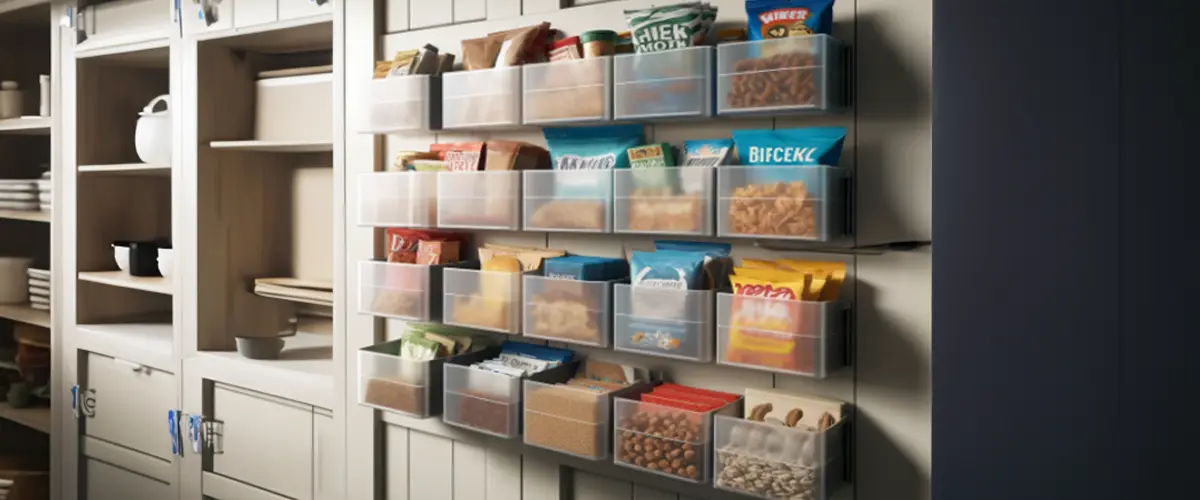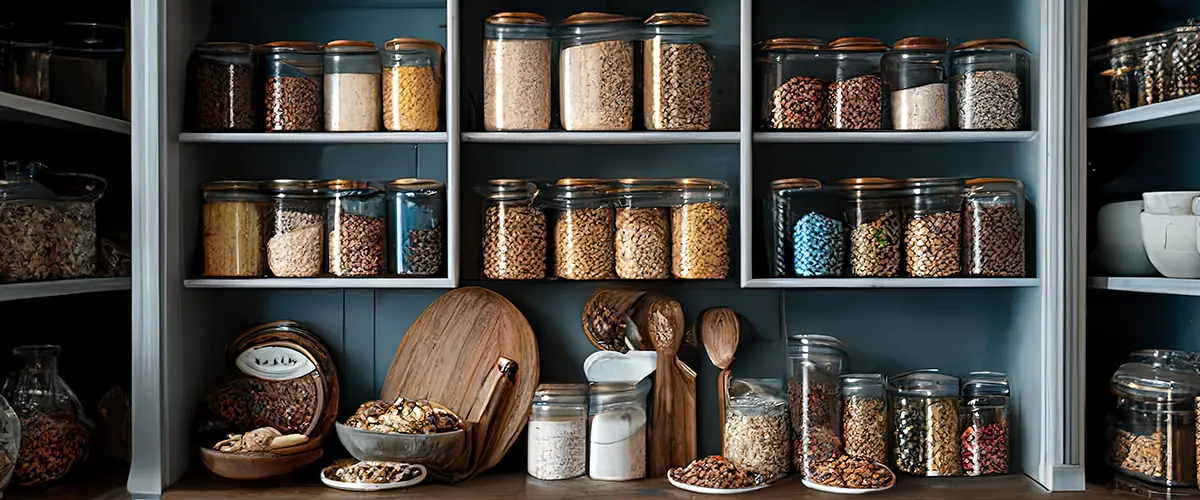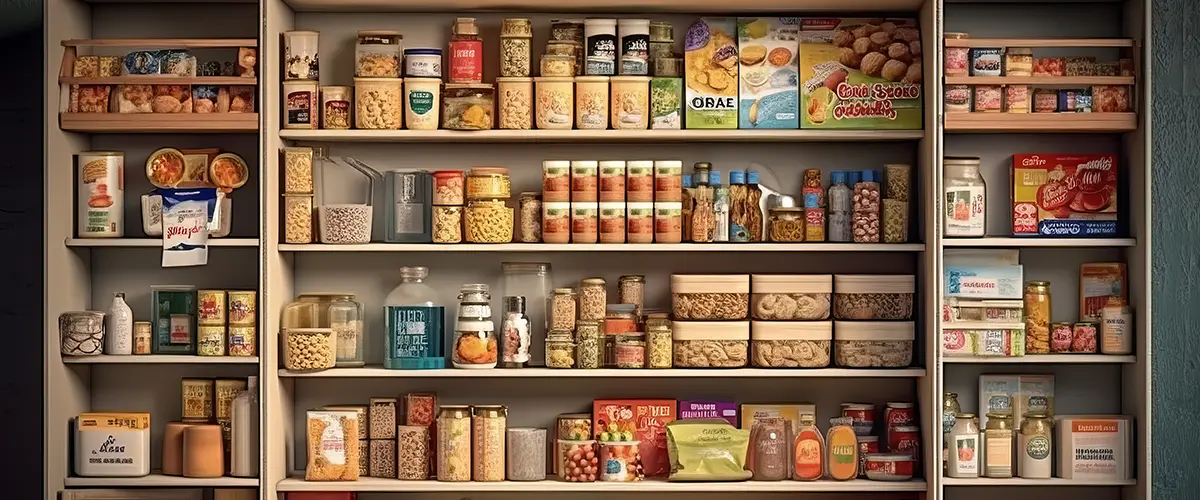Kitchen pantries are dark, room-temperature environments full of endless (well, to a bug) supplies of food. If you were an insect, you’d be in heaven. Certain species of pests gravitate more towards pantries than others.
Once you know them, you can identify them in your kitchen and quickly eradicate them.

Fruit Flies
The fruit fly earned its name because of its preference for decaying vegetables and fruits. This microscopic insect loves other sources of sugar as well. They’re also great at hiding.
Fruit flies can sneak into your egg cartons or your grocery bags, where they’ll get in your house and reproduce, making your life harder.
How To Prevent Fruit Flies In The Kitchen Pantry
To get rid of fruit flies, start by eliminating their breeding grounds. Dispose of any overripe or rotting fruits, and clean out drains and garbage disposals. Create a simple trap using a container with apple cider vinegar and a few drops of dish soap.
Cover it with plastic wrap and poke small holes in the wrap. Fruit flies will be attracted to the vinegar and get trapped inside.
Cockroaches
How To Prevent Cockroaches In The Kitchen Pantry
Merchant Grain Beetles
How To Prevent Merchant Grain Beetles In The Kitchen Pantry

Flour Beetles
You may have never heard of a flour beetle, but you’ll want to familiarize yourself with it quickly. These beetles are very tiny, under five millimeters apiece. They have a brownish-red hue and love to eat pet food, cereal, and flour.
Due to their size and color, it’s nearly impossible to detect them in anything but flour, especially if they start burrowing.
How To Prevent Flour Beetles In The Kitchen Pantry
Grain Weevils
How To Prevent Grain Weevils In The Kitchen Pantry
Indian Meal Moths
How To Prevent Indian Meal Moths In The Kitchen Pantry
Ants
Another common culprit in many a kitchen is the humble ant. Ants can get in through your windows and door seals, and they tend to bring a lot of their friends with them.
Once that happens, more and more ants can accumulate, making them hard to get rid of without an exterminator.
How To Prevent Ants In The Kitchen Pantry

How To Properly Maintain Your Kitchen Pantry Organization
You probably have the heebie-jeebies after reading about all those bugs, but it was necessary. Now, here are some expanded tips from the intro on how to get rid of these kitchen pantry critters for good.
Keep Your Pantries Clean
If you’re like most homeowners, you leave your custom pantries closed unless you’re using them, right? In the meantime, critters can get in there, reproduce, and cause quite a significant problem.
At least every few months, you want to open your pantries wide, take out everything in there, and clean the shelves from top to bottom.
Don’t just use soap and water when cleaning. Fruit flies, one common insect found in kitchen pantries, hate any cleaners with vinegar in them.
Before you put your food back in, inspect each item for tears and other signs of packaging damage. That’s one common sign of infestation for the pantry pests that can break through packaging.
Don’t Leave Open Food In Your Pantries
You’re always very cautious about which foods go in the pantry, but perhaps your spouse or kids aren’t. They leave open containers without clips, which is just inviting bugs to come in and invade your kitchen.
Make sure that anyone who opens food containers, packages, and bags have some means of sealing them back up. Clips work, as do twist ties.
Upgrade To Airtight Containers
What’s an even safer option is switching to glass, plastic, or metal containers with airtight lids. Remember, grain weevils can break your food packaging, so even if the top of the bag is clipped, if the weevil gets in through the bottom, then it doesn’t matter.
Labeling your foods or putting them in translucent jars and containers will allow you to easily identify everything in your pantry.

Clean Up Messes Right Away
This is an obvious tip, but it’s one worth mentioning anyway. If you or another member of the family happens to spill something (and hey, it happens), these messes cannot be left to sit.
Sure, the insect species on the list above will hide in your pantry, but they don’t have to live there exclusively. They’ll go wherever the food is. If that’s right on your kitchen counter, then hey, it’s a lot easier for the bug to eat than having to go all the way to the pantry.
Whether it’s a liquid mess (remember, fruit flies love sugar), crumbs, a few pieces of cereal, or some errant popcorn kernels, it’s got to go right away.
Use Bay Leaves
You can also try the bay leaf trick. Bay leaves are sizable leaves, with an aromatic flavor that makes them perfect for cooking garnishes. You can place a whole fresh leaf or add a few sprinkles of dried bay leaves to your custom pantry shelves.
If you use your pantries for storing grains especially, then add a package or two of bay leaves. Leave these packages open. Ants are especially averse to bay leaves, mostly because the smell is so strong to them.

FAQ: How To Get Rid Of And Prevent Kitchen Pantry Pests
What are common signs of pantry pests?
Look for small insects, webbing in food packages, and holes in packaging. You might also notice tiny droppings or a musty smell.
How do I get rid of pantry pests?
Start by discarding infested items. Clean the pantry thoroughly with soap and water, and vacuum crevices to remove any remaining pests.
What foods attract pantry pests?
Pantry pests are often drawn to grains, cereals, flour, dried fruits, nuts, and spices. Make sure these items are stored properly.
How can I prevent pantry pests in the future?
Store food in airtight containers, keep the pantry clean and dry, and regularly check for signs of pests. Rotate food items to use older products first.
Are there natural ways to repel pantry pests?
Yes, you can use bay leaves or cloves inside pantry shelves as natural repellents. Regularly cleaning and maintaining a dry pantry also helps prevent pests.
Conclusion
For those seeking a tailored solution to their kitchen pantry needs, look no further than Creative Closets. Our company specializes in designing and installing custom kitchen pantries that seamlessly integrate functionality and style.
If you’re tired of dealing with pests or simply want a pantry that maximizes your space, give us a call at (425) 428-5073 or send us a message.
Let our expert team create a kitchen pantry that not only meets your storage requirements but also adds a touch of elegance to your kitchen. Say goodbye to pests and hello to a beautifully organized pantry with Creative Closets.
